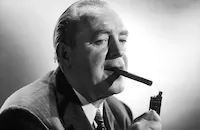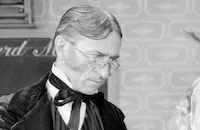I Married a Doctor
Brief Synopsis
Cast & Crew
Archie Mayo
Pat O'brien
Josephine Hutchinson
Ross Alexander
Guy Kibbee
Louise Fazenda
Film Details
Technical Specs

Synopsis
When small town doctor Will P. Kennicott marries Carol, a Chicago woman, the townspeople are displeased that he has married an outsider. Carol is determined to make friends, but the town's women resent her popularity with the men. She further alienates everyone with her suggestions on how to fix up the town, which they all think looks fine the way it is. She befriends Erik Valborg, a young man with artistic inclinations. In a gesture of support, she encourages him to leave the farm and study architecture in the city. His parents are convinced that she has seduced him. Erik, himself, is sure that Carol is in love with him and says as much to Will. At Will's suggestion, Erik asks Carol to leave with him. She is stunned, admitting that she sees him only as a friend. In despair, Erik gets drunk and is killed in a car crash. When Carol realizes that the whole town blames her for Erik's death, she decides to leave. All her efforts to fit in have failed, and although Will begs her to stay, she takes the next train out of town. After she is gone, the townspeople hypocritically claim to miss her. Will is so sure that she will come back that he waits every afternoon for the train from the city. One afternoon, Carol does return, having learned that there are small minds everywhere and that her love for Will is what is important.

Director

Archie Mayo
Cast

Pat O'brien

Josephine Hutchinson

Ross Alexander

Guy Kibbee

Louise Fazenda

Olin Howland
Margaret Irving
Alma Lloyd

Grace Stafford
Ray Mayer

Robert Barrat
Hedwiga Reicher
Willard Robertson
Edythe Elliott
Thomas Pogue
Janet Young
Harry Hayden
Frank Rhodes

Gaby Fay
Sam Wren
Dora Clement
Raymond Brown
Frank Sully
Ralph M. Remley
Jacqueline Saunders
Lottie Williams
Russ Powell

Tom Wilson

Edward Mcwade
Dorothy Vaughan
George Guhl

George Hayes
Crew

Film Details
Technical Specs

Articles
I Married a Doctor
The story is about a sophisticated Chicago woman (Josephine Hutchinson) who marries a small-town doctor (Pat O'Brien) and moves to that town, where she has trouble fitting in and is subjected to all sorts of petty gossip and resentment, leading to tragedy and threatening the marriage. The New York Times found it "compactly written, expertly performed, and much more than one has any right to expect from its title" -- until the "regrettable" cop-out of an ending, which was changed 180 degrees from that of the novel.
Variety also gave the film top marks, praising the "sterling thespianism and one of the most intelligent directorial jobs turned out by Archie Mayo.... Pat O'Brien tops his own best previous efforts in a finely paced portrayal." Indeed, O'Brien is more restrained than usual here, and it pays off.
In his memoir, The Wind at my Back, O'Brien had nice things to say about his co-star Josephine Hutchinson. One of his favorite films, he wrote, was Oil for the Lamps of China (1935), in which the pair had first played husband and wife on screen. (They had also done so on Broadway ten years earlier, in A Man's Man.) Like everyone else, O'Brien thought the title "I Married a Doctor" was ludicrous: "The title was changed...on the theory, I suppose, that a world-famous novel that rocked around the world might confuse non-readers, a book that helped get Sinclair Lewis the Nobel Prize."
This was one of the last films for actor Ross Alexander, who plays townsman Erik Valborg and who had previously appeared in A Midsummer Night's Dream (1935) and Captain Blood (1935). His life was already heading into tragedy. A promising actor, he had married actress Aleta Friele in 1934 as a cover to hide his homosexuality, which at the time would have been a career killer if made public. A month before I Married a Doctor started production, Friele committed suicide in their Hollywood Hills home, distraught by marriage and career problems. Alexander remarried several months later, to actress Anne Nagel, but he remained deeply troubled and committed suicide himself in early 1937, barely a year after Friele had done the same.
I Married a Doctor was one of Byron Haskin's final outings as cinematographer. Shortly afterward, he moved full-time into the field of special effects, at which he proved so successful that he was nominated for four Oscars®. In 1947 Haskin shifted gears again and became a director, turning out such films noirs as I Walk Alone (1948) and Too Late for Tears (1949), and later on such classic sci-fi as The War of the Worlds (1953) and Robinson Crusoe on Mars (1964). Haskin was a true technical pioneer of the film industry who had much to do with enabling the movies' transition to sound.
Actress Louise Fazenda, who appears as the Swedish maid Bea Sorenson, played the same role in the earlier 1923 film version of Main Street.
Producer: Hal B. Wallis (uncredited)
Director: Archie Mayo
Screenplay: Casey Robinson (screenplay); Harriet Ford, Harvey O'Higgins (dramatisation); Sinclair Lewis (novel)
Cinematography: Byron Haskin
Art Direction: Carl Weyl
Music: Heinz Roemheld (uncredited)
Film Editing: Owen Marks
Cast: Pat O'Brien (Dr. Will P. Kennicott), Josephine Hutchinson (Carol Kennicott), Ross Alexander (Erik Valborg), Guy Kibbee (Samuel Clark), Louise Fazenda (Bea Sorenson), Olin Howland (Dave Dyer), Margaret Irving (Maude Dyer).
BW-83m.
by Jeremy Arnold

I Married a Doctor
Quotes
Trivia
Notes
An article in Liberty noted that the popularity of movies about doctors led the studio to change the title from Main Street. Louise Fazenda played a role in the 1923 Warner Bros. film, Main Street, which was also based on the Sinclair Lewis novel and was directed by Harry Beaumont and starred Florence Vidor and Monte Blue (see AFI Catalog of Feature Films, 1921-30; F2.3348).















